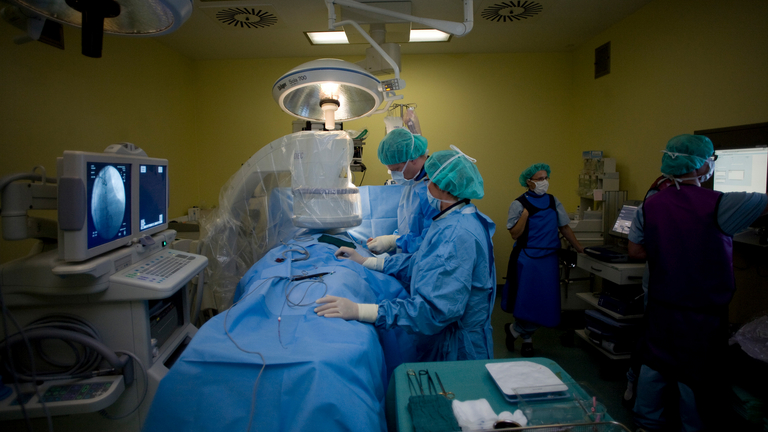
Peripheral vascular surgery
Some patients with narrowing of the arteries in the neck, pelvis or legs, as well as some patients with aneurysms, may be able to be treated using catheter-based procedures. This often involves the use of balloon catheters and stents. Vascular surgery comprises both open surgery techniques and catheter-based procedures, with the latter now playing a significant role.
Contact
What are catheter-based vascular procedures?
The majority of catheter-based vascular procedures are used to treat patients with narrowing of the arteries that affects the neck, pelvis or legs. Aortic aneurysms are also often treated using catheter-based procedures. Catheter-based interventions used to treat arterial disease are usually performed using access sites in the groin. These access sites (which are similar to those used in catheter-based interventions involving the heart) are used to introduce balloon catheters to widen stenotic vessels, as well as stents to support the blood vessels from the inside.
What conditions are treated with this type of procedure?
Catheter-based interventions can be used to treat a variety of conditions affecting different parts of the body:
- Carotid stenosis (narrowing of the carotid artery) - particularly in patients where open surgery is not feasible.
- Aortic aneurysms - in particular abdominal aneurysms but also certain aneurysms in the chest area (thoracic aneurysms). In some cases, catheter-based techniques can be combined with open surgery procedures.
- Shorter sections of narrowing affecting the blood vessels in the pelvis and legs (peripheral arterial disease). Catheter-based techniques are used mainly as part of interventions to treat the iliac arteries (situated in the pelvis).
- Catheter-based techniques may also be used in some patients with acute arterial occlusions. These may occur as a result of an arterial embolism in one of the arteries in the leg, and may require an emergency intervention to prevent tissue death and amputation of the affected limb. Many patients with acute arterial occlusions will, however, require open surgical procedures.
- Renal artery stenosis (narrowing of the renal artery) - A reduction in the normal blood flow through the kidneys triggers the release of certain hormones, and can result in renovascular hypertension. In some cases, renal artery stenosis may also cause renal failure. Balloon angioplasty to widen a stenotic artery, followed by the implantation of a stent to support the affected artery from the inside, are considered the standard method of treatment in patients with severe stenosis.
When should this type of procedure be used?
The aim of treatment is to eliminate the reason behind the reduction in blood flow to organs and tissues. Arterial stenoses usually occur as a result of long-term damage from atherosclorosis (hardening of the arteries), a process that is facilitated by risk factors such as smoking, high blood pressure, diabetes and abnormalities in lipid metabolism. Atherosclerosis can have serious consequences, which range from coronary heart disease to the risk of stroke as a result of carotid artery stenosis, and can even include pain while walking (claudication) caused by stenosis affecting the arteries of the pelvis and the legs (peripheral arterial disease).
What happens during this type of procedure?
If the stenosis can be treated using catheter-based procedures, treatment typically involves a procedure known as balloon angioplasty: a balloon catheter is inserted via a blood vessel in the groin and, using x-ray guidance, is advanced into the site of stenosis, where it is inflated. In addition to balloon angioplasty, treatment usually involves the implantation of a tube-shaped wire frame (stent), which helps to support the blood vessel from the inside. This type of intervention is usually performed using only a local anesthetic. The techniques involved in the treatment of aortic aneurysms constitute a highly specialized type of catheter-based procedure.
Most aneurysms occur in the abdominal section of the aorta and, once they reach a certain size, the patient is at risk of aortic dissection (rupture). Catheter-based techniques can be used to insert an endovascular stent - a prosthesis consisting of a wire frame coated in synthetic materials - via an artery in the groin, and position it inside the aorta. Once the stent has been anchored inside the aorta by latching on to healthy tissue on both sides of the aneurysm, blood begins to flow through the tube-shaped prosthesis, thus completely excluding the weakened section.
A catheter-based procedure typically consists of the following steps:
- A small incision is made in an artery in the groin, through which a balloon catheter is inserted and advanced to the site of the stenosis.
- The physician carefully inflates the balloon to widen the stenotic section.
- A folded stent is then inserted into the affected section of the artery. Once the tube-shaped wire mesh has self-expanded, a balloon catheter is used to expand it fully, ensuring it is pressed against the artery walls.
- If the stenosis is situated close to the aortic bifurcation and affects both of the iliac arteries in the pelvis, balloon catheters can be inserted simultaneously via both the left and right femoral arteries ("kissing balloon" angioplasty).
- Once the angioplasty procedure has been completed, the catheters are removed from the vessels in the groin, and pressure bandages are applied to the entry sites.
